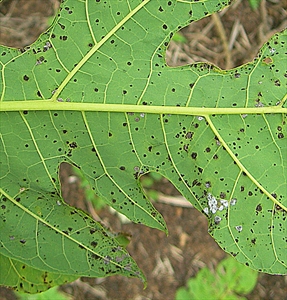Black spot
Pacific Pests, Pathogens, Weeds & Pesticides - Online edition
Pacific Pests, Pathogens, Weeds & Pesticides
Papaya black spot (158)
Asperisporium caricae; previously Cercospora caricae.
Asia, Africa, North , South and Central America, the Caribbean, Oceania. It is recorded from Australia, Fiji, French Polynesia, New Caledonia, and Solomon Islands.
Papaya
Leaf spots, round to irregular, 3-6 mm diameter, develop on the older leaves; they are pale brown above with a yellow margin; below, spores develop turning the spots to dark brown or black (Photos 1&2). If the leaves are severely infected they turn brown and die. Spots on the fruit are also brown to black and slightly sunken.
The black lesions may become white if hyperparasitised by fungi such as Cephalosporium, Rhinotrichum or Verticillium (Photo 3).
The spores from the underside of the leaves are spread in wind and wind-driven rain. Long distance spread occurs when the fruits are traded at markets.
Usually, the disease is a minor problem, although heavily spotted leaves result in extensive leaf fall. If this occurs, the growth of the trees is affected, and fruit yield is lower than on healthy trees. Infection of young fruit also causes them to fall, and infections on mature fruit affect their market quality. The disease is worse in wet weather.
Look for the dark brown to black spots on the fruit and on the underside of the leaves where the spores are produced; on the top surface the spots are light brown with yellow margins, and fade in colour as they age. Look for spots mostly on the older leaves. Look to see if the leaves dry and die early when the spotting is severe. Look for the spots on the leaves from below, up into the crown of the tree.
CULTURAL CONTROL
Cultural control is particularly important in the management of this disease. Remove infected leaves and fruit as soon as they are seen, take them out of the plantation and burn them.
RESISTANT VARIETIES
None are known to be resistant.
CHEMICAL CONTROL
Use protectant fungicides, such as those containing copper, mancozeb or chlorothalonil. Make sure that the undersides of the leaves are sprayed, as this is where the spores are produced. In Australia, tebuconazole is registered for use against this disease. Alternate sprays of this systemic fungicide with one of the three protectants mentioned.
____________________
When using a pesticide, always wear protective clothing and follow the instructions on the product label, such as dosage, timing of application, and pre-harvest interval. Recommendations will vary with the crop and system of cultivation. Expert advice on the most appropriate pesticide to use should always be sought from local agricultural authorities.
AUTHOR Grahame Jackson
Information from Diseases of fruit crops in Australia (2009). Editors, Tony Cooke, et al. CSIRO Publishing; and CABI (2019) Asperisporium caricae (black spot). Crop Protection Compendium. (https://www.cabi.org/cpc/datasheet/7521); and from Liberato JR, et al. (2006) Asperisporium black spot of papaya (Asperisporium caricae): PaDIL - http://www.padil.gov.au.
Produced with support from the Australian Centre for International Agricultural Research under project PC/2010/090: Strengthening integrated crop management research in the Pacific Islands in support of sustainable intensification of high-value crop production, implemented by the University of Queensland and the Secretariat of the Pacific Community.






